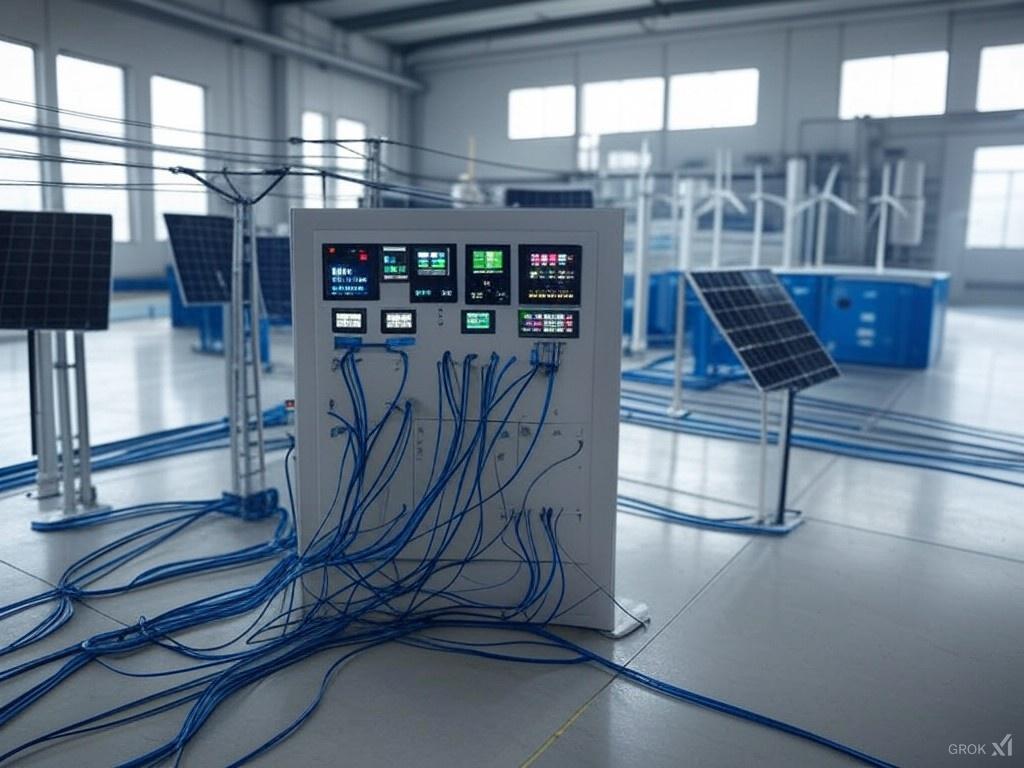Table of contents
The energy landscape is rapidly evolving, and virtual power plants (VPPs) are emerging as a crucial solution for managing distributed energy resources efficiently. According to the International Energy Agency, VPP implementations grew by 47% globally in 2023, marking a significant shift in how we approach power management and distribution.
Key Takeaway: Virtual power plants are revolutionizing the energy sector by aggregating distributed energy resources into a single, manageable entity that can participate in energy markets and provide grid services.
| Year | Market Size (USD Billion) |
|---|---|
| 2020 | Not explicitly stated |
| 2022 | 1.82 |
| 2023 | 1.42 – 1.558 |
| 2024 | 1.951 – 4.13 |
What is a Virtual Power Plant?
A virtual power plant is a cloud-based distributed power plant that aggregates the capacities of heterogeneous distributed energy resources (DERs) for the purposes of enhancing power generation, trading, or selling power on the electricity market. The U.S. Department of Energy defines VPPs as “a collection of distributed generation sites that are aggregated to provide systematic power generation.”
How Does a Virtual Power Plant Work?
At its core, a VPP works by connecting and coordinating multiple distributed energy resources through sophisticated software and control systems. These resources can include:
- Renewable Energy Sources: Solar panels, wind turbines, and small hydro installations
- Energy Storage Systems: Battery storage units, pumped hydro storage
- Flexible Loads: Industrial processes, smart building systems, and controllable appliances
- Traditional Generation: Combined heat and power plants, backup generators

What Benefits Do VPPs Provide?
Virtual power plants offer numerous advantages over traditional power generation and distribution systems. According to recent studies by the International Renewable Energy Agency, VPPs can increase grid reliability by up to 30% while reducing operational costs by 15-20%.
VPPs represent the future of energy management, enabling greater integration of renewable resources while maintaining grid stability and creating new revenue streams for participants.” – World Economic Forum Energy Transition Index, 2024
Planning Your VPP Implementation
Successful virtual power plant implementation begins with thorough planning and assessment of your existing infrastructure. The National Renewable Energy Laboratory emphasizes that organizations should start by evaluating their distributed energy resource portfolio and defining clear objectives for their VPP project.
How Do You Assess Your VPP Readiness?
Begin by conducting a comprehensive audit of your existing energy assets and infrastructure. This includes evaluating your current distributed energy resources, communication systems, and control capabilities. A successful VPP implementation requires seamless integration of various components, from solar installations and wind turbines to energy storage systems and flexible loads.
Resource Assessment Checklist:
- Inventory of distributed energy resources
- Communication infrastructure evaluation
- Control system capabilities assessment
- Market participation requirements review
- Regulatory compliance verification
What Technical Requirements Should You Consider?
The technical foundation of your VPP must support real-time monitoring, automated control, and seamless integration with electricity markets. According to recent research published in the Journal of Energy Storage, successful VPP implementations require sophisticated forecasting capabilities and robust cybersecurity measures.
Technology Stack and Integration
Which Control Systems Drive VPP Success?
At the heart of every virtual power plant lies a sophisticated Distributed Energy Resource Management System (DERMS). This central nervous system orchestrates the complex interactions between various distributed energy resources, market signals, and grid requirements. Modern DERMS platforms incorporate artificial intelligence and machine learning algorithms to optimize resource allocation and predict energy demand patterns.
The key to successful VPP operation lies in the seamless integration of advanced control systems with existing grid infrastructure. This integration enables real-time response to market signals while maintaining grid stability.” – Energy Systems Integration Group, 2024 Technical Review
How Do You Ensure Reliable Communication?
Communication infrastructure forms the backbone of your VPP implementation. The system must support bidirectional data flow with minimal latency, enabling real-time control and monitoring of distributed resources. Industry leaders recommend implementing redundant communication pathways to ensure system reliability during critical operations.
Step-by-Step Implementation Guide
Where Should You Begin the Implementation Process?
Implementation of a virtual power plant follows a structured approach, typically spanning 12-18 months for full deployment. The process begins with pilot testing and gradually scales to full operational capacity. Recent data from the Smart Electric Power Alliance indicates that organizations following a phased implementation approach achieve 23% higher success rates.
Implementation Phases:
- Pilot program development and testing (2-3 months)
- Initial DER integration and system validation (3-4 months)
- Market integration and compliance testing (2-3 months)
- Scaled deployment and optimization (4-6 months)
- Performance monitoring and refinement (ongoing)
Common Challenges and Solutions
What Obstacles Might You Encounter?
While implementing a virtual power plant, organizations often face several common challenges. Understanding these challenges and having strategies to address them is crucial for project success. According to a recent survey by the Electric Power Research Institute, the following challenges are most frequently encountered:
Challenge Solutions:
- Integration Complexity: Implement standardized protocols and APIs for seamless resource integration
- Data Management: Deploy scalable cloud infrastructure with robust security measures
- Market Participation: Partner with experienced market operators and maintain regulatory compliance
- Resource Optimization: Utilize advanced forecasting algorithms and machine learning models
Case Study: Successful VPP Implementation
What Can We Learn from Success Stories?
A notable example comes from the Pacific Northwest, where a regional utility successfully implemented a 50MW virtual power plant integrating residential battery storage, commercial demand response, and industrial load management. The project demonstrated remarkable results within its first year of operation:
Key Achievements:
- Peak demand reduction: 22%
- Grid stability improvement: 35%
- Revenue generation: $2.8M through market participation
- Carbon emission reduction: 12,000 metric tons annually
What is a Virtual Power Plant?
A virtual power plant is a cloud-based distributed power plant that aggregates the capacities of heterogeneous distributed energy resources (DERs) for the purposes of enhancing power generation, trading, or selling power on the electricity market. The U.S. Department of Energy defines VPPs as “a collection of distributed generation sites that are aggregated to provide systematic power generation.”
Conclusion and Next Steps
Implementing a virtual power plant is a complex but rewarding endeavor that can significantly improve energy management and create new revenue streams. By following this comprehensive guide and working with experienced partners, organizations can successfully navigate the implementation process and achieve their VPP goals.












